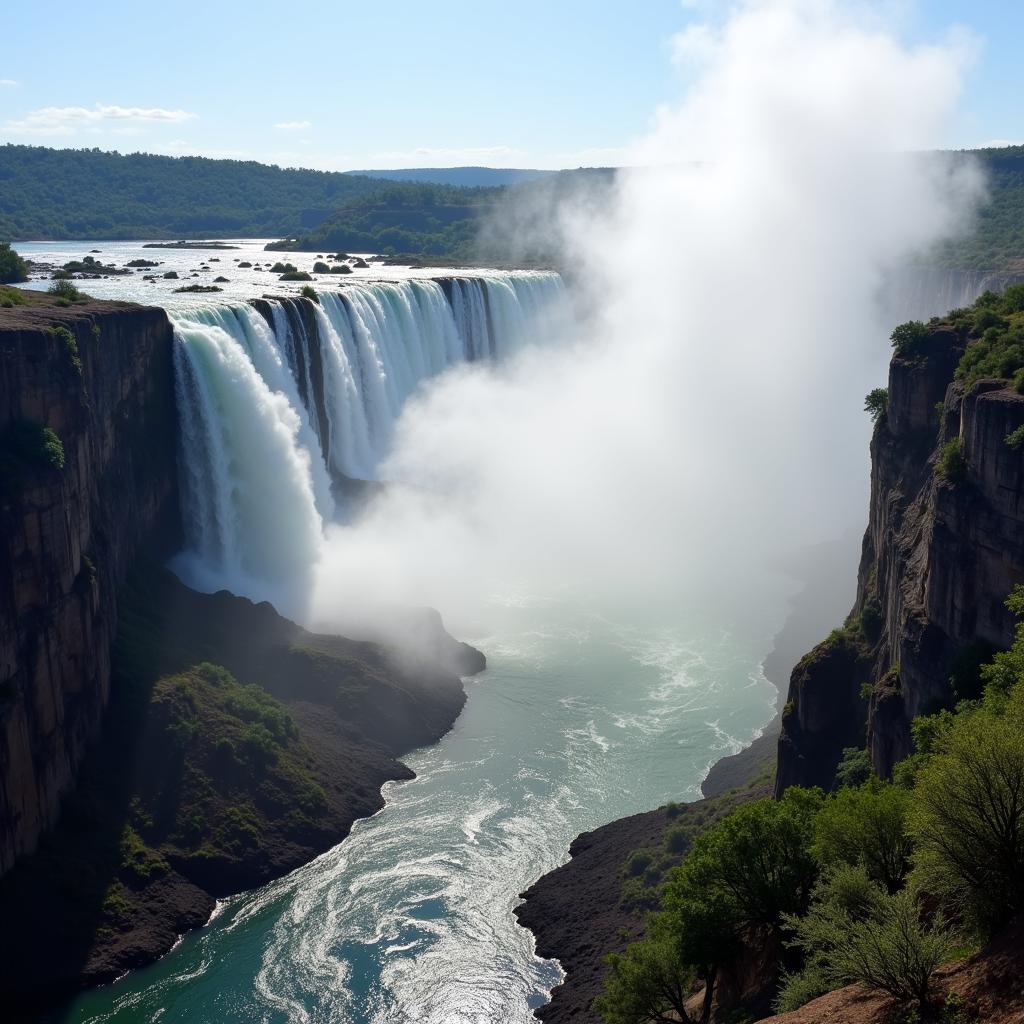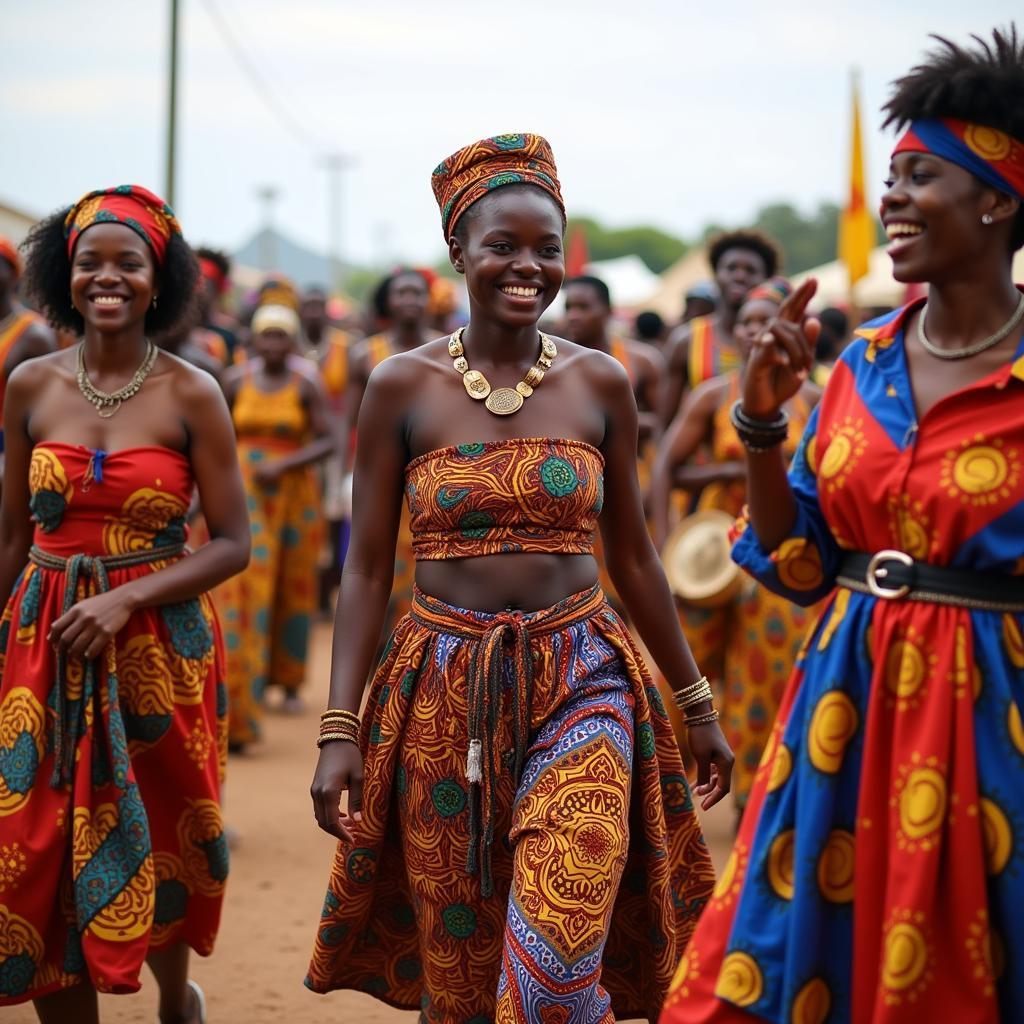Unveiling African Landscape Facts: A Journey Through Breathtaking Diversity
Africa, a continent of vibrant cultures and breathtaking landscapes, offers a diverse tapestry of natural wonders. From the Sahara Desert’s sweeping sands to the lush rainforests of the Congo Basin, African Landscape Facts reveal a continent of remarkable contrasts and unparalleled beauty. This exploration delves into the fascinating geographical features that define Africa’s stunning scenery. Let’s embark on a journey to discover the wonders that await.
Majestic Mountains and Towering Volcanoes
Africa boasts a range of impressive mountain ranges, each with unique geological formations and ecological significance. Mount Kilimanjaro, the highest peak in Africa, stands as a testament to the continent’s geological power. The Ethiopian Highlands, often referred to as the “Roof of Africa,” offer stunning views and harbor unique biodiversity. Active volcanoes like Mount Nyiragongo in the Democratic Republic of Congo and Mount Cameroon add a dramatic element to the landscape, shaping the terrain with their fiery eruptions. These majestic peaks not only provide breathtaking views but also play a crucial role in influencing weather patterns and creating diverse habitats. What factors have shaped the diverse mountain ranges across Africa? The interplay of tectonic plate movements, volcanic activity, and erosion has sculpted these magnificent features over millions of years, resulting in a stunning array of landscapes.
The vibrant tapestry of African government facts showcases the political structures shaping this dynamic continent, adding another layer of complexity to understanding its landscapes and people.
Vast Deserts and Arid Landscapes
The Sahara Desert, the largest hot desert in the world, dominates a significant portion of North Africa. Its endless sand dunes, sculpted by wind and time, create an otherworldly landscape. Other notable deserts, such as the Namib Desert and the Kalahari Desert, present unique challenges and opportunities for the flora and fauna that have adapted to their harsh conditions. What are the key features of the Sahara Desert? The Sahara is characterized by extreme temperatures, sparse vegetation, and vast stretches of sand dunes, rocky plateaus, and gravel plains. Despite its harsh environment, it harbors a surprising variety of life, from hardy plants to specialized desert animals.
Lush Rainforests and Diverse Ecosystems
The Congo Basin, home to the second largest rainforest in the world, teems with biodiversity. Its dense vegetation, intertwined rivers, and abundant wildlife create a vital ecosystem. Other forested regions, such as those in West Africa and Madagascar, harbor unique species and play a critical role in maintaining the ecological balance of the continent. How does the Congo Basin contribute to global biodiversity? The Congo Basin, with its vast expanse of rainforest, is a biodiversity hotspot, harboring an incredible array of plant and animal species, many of which are found nowhere else on Earth. It plays a crucial role in regulating global climate patterns and providing essential ecosystem services.
The complex and dynamic nature of African economy facts is intertwined with the continent’s diverse landscapes, offering insights into the resources and challenges shaping its future.
Breathtaking Coastlines and Coastal Wetlands
Africa’s extensive coastlines, bordering the Atlantic and Indian Oceans, offer stunning beaches, dramatic cliffs, and diverse marine life. Coastal wetlands, such as mangroves and estuaries, provide essential habitats for numerous species and protect against coastal erosion. What is the significance of mangrove forests along African coastlines? Mangrove forests act as natural barriers against storm surges and coastal erosion, providing vital protection for coastal communities. They also serve as nurseries for numerous marine species and play a critical role in maintaining the health of coastal ecosystems.
The intricate designs found in African elephant cut out reflect the continent’s rich artistic heritage and celebrate the iconic wildlife that roams its landscapes.
Shaping the Landscape: The Role of Climate and Erosion
Climate plays a crucial role in shaping African landscapes. Rainfall patterns, temperature variations, and wind erosion have sculpted the continent’s diverse terrain over millions of years. The Sahara Desert’s expansion and contraction, the formation of canyons and valleys, and the shaping of coastal dunes are all influenced by the interplay of climate and geological processes. What are the major factors influencing erosion in African landscapes? Rainfall, wind, and temperature fluctuations contribute significantly to erosion, shaping mountains, carving valleys, and shaping coastal regions. Human activities, such as deforestation and agriculture, can also accelerate erosion, leading to land degradation and environmental challenges.
 Victoria Falls Zambezi River
Victoria Falls Zambezi River
Conclusion: Preserving Africa’s Natural Heritage
African landscape facts reveal a continent of unparalleled beauty and diversity. From towering mountains to vast deserts, lush rainforests to stunning coastlines, Africa’s landscapes offer a glimpse into the Earth’s rich natural heritage. Understanding and preserving these invaluable ecosystems is crucial for the future of the continent and the planet. African landscape facts continue to inspire awe and wonder, reminding us of the power and beauty of the natural world.
FAQ
- What is the highest mountain in Africa? Mount Kilimanjaro.
- What is the largest desert in Africa? The Sahara Desert.
- What is the longest river in Africa? The Nile River.
- What is the significance of the Great Rift Valley? It is a geological wonder showcasing tectonic plate movement.
- What are some examples of unique African wildlife? Lions, elephants, giraffes, rhinos, and gorillas.
- What are the major threats to African landscapes? Climate change, deforestation, and human encroachment.
- How can we contribute to the preservation of African landscapes? Supporting conservation efforts, promoting sustainable tourism, and raising awareness about environmental issues.
Do you have further questions about other aspects of Africa? Perhaps you might find the following resources helpful: African American sermon manuscripts and African American clothing catalogs. These resources provide valuable insights into the rich cultural heritage of African Americans.
If you need any assistance, please contact us at +255768904061, email us at kaka.mag@gmail.com, or visit us at Mbarali DC Mawindi, Kangaga, Tanzania. Our customer service team is available 24/7.

